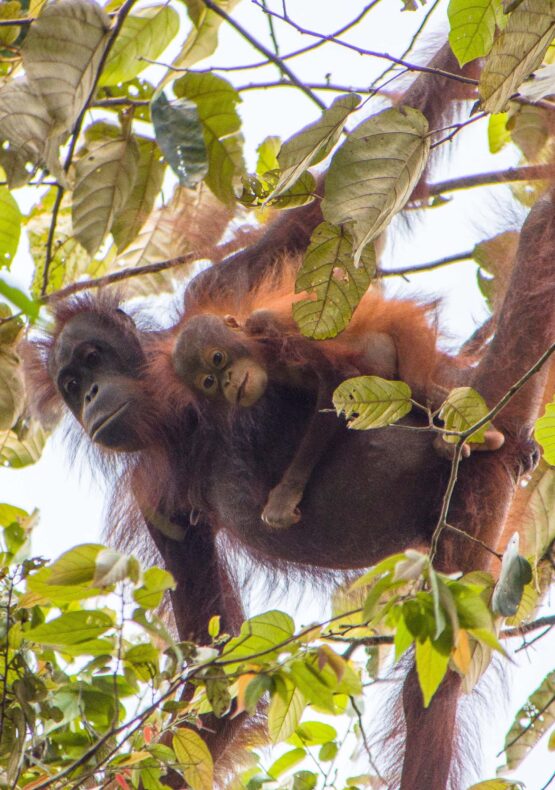The island of Borneo is a world hotspot for endangered species. Join Mike on this tour to Borneo which highlights the critical status of one of the finest primates of this planet, the Orangutan. We will spend time in the ecosystem that supports it, and also look at the threats that are pushing it towards extinction. On this tour, we will experience many enjoyable dimensions of natural history, adventure, culinary, and ecotourism.
Borneo: Land of Primates, Cats, and Birds
Our Birding in India webinar series has left the country…!
Itinerary
Day 1: Sepilok Forest Reserve
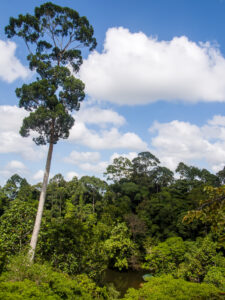
Arrive in Sandakan (e.g. from Kuala Lumpur) by lunchtime. Travel 30 minutes to Sepilok Nature Lodge and settle into your accommodation.
Sepilok is a primary rainforest reserve. Within the reserve is The Orangutan Rehabilitation centre and the Sun bear rescue centre. The rest of the reserve is the Rainforest Discovery centre. The forest boasts an array of birds and small mammals, including tarsier, stink badgers and, if you’re lucky, you can see orangutans.
The Orangutans have been rehabilitated and released back into their natural habitat. Please note that they are semi wild and more unpredictable than wild orangutans, as they are not afraid of humans. This is not a zoo and they are free to wonder where they want.
You’ll visit the Orangutan centre in the afternoon. After an early dinner, you will visit the Rainforest discovery centre. This offers the best view and photo opportunities of the flying squirrels.
Day 2: Sepilok
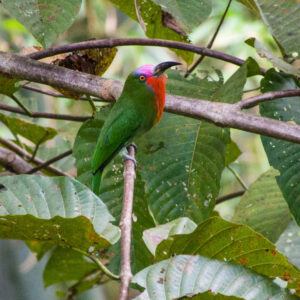
Start your day at the rainforest discovery centre for a morning of bird watching. This is one of the best places to see the Bornean Spiderhunter and the Bornean Bristlehead.
The rest of the day can be discussed with your guide. You may like to spend it exploring the discovery centre and/or visit the Sun Bear sanctuary.
After dinner, another chance to find some nocturnal creatures on your night walk.
Day 3: Sepilok to Kinabatangan
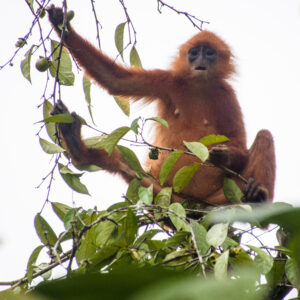
After some pre-breakfast birding, depart Sepilok at 10am and travel 2 hours to Sukau village.
The mighty Lower-Kinabatangan River sustains one of the world’s richest ecosystems. It is also recognized as Sabah’s first and Malaysia’s largest RAMSAR site. Other than being home to Borneo’s indigenous orangutan and proboscis monkey, the surrounding forest is one of only two known places in the world where 10 species of primates can be found.
This is Malaysia’s second-longest river with a massive length of 560km from its source in Southwest Sabah to its outlet at the Sulu Sea, on the East Coast. 26,000 hectares was gazetted as the Kinabatangan Wildlife Sanctuary under the State’s Wildlife Conservation Enactment of 1997.
Lunch will be served upon arrival. Your first river cruise will begin at 4.30 pm and last for about 2 hours. Dinner is served at 7pm before a relaxed night-walk.
Days 4-5: Kinabatangan River

Wake up to the calls of birds, insects and animals as the pre-dawn chorus begins at 6.30am take a morning cruise.
After breakfast, explore the bird life around the accommodation. You’ll have more free time, so spend the day at your own pace/leisure before the 4.30pm river cruise. There is an optional night river cruise weather permitting (payment by yourselves).
Day 6: Kinabatangan to Tabin Wildlife Reserve
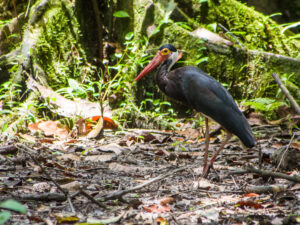
Depart Kinabatangan at 9.30 am and travel 2.5 hours to Lahad Datu. Here you will change vehicles and continue another 1.5 hours to Tabin Wildlife Reserve.
Tabin contains a variety of terrain ranging from brackish water swamps at sea-level in the north-east to the central mountain ranges, of which Mount Hatton (571 m) is the highest.
Rugged mountain ranges that are dissected by deep ravines and steep-sided river valleys dominate most of the central, western and southern regions of the reserve.
In these parts of the reserve, there are over 15 peaks, 500 or more metres in height. In addition, there are at least 30 peaks between 300 and 500 metres high.
Lunch is served upon arrival. The itinerary is very flexible here as you have your own local guide with you. There are many trails, roads to explore which are fantastic for bird watching. After dinner, enjoy a CD/Slide presentation on Tabin’s natural wonders, followed by a night safari to look out for nocturnal wildlife and birds.
Day 7: Tabin
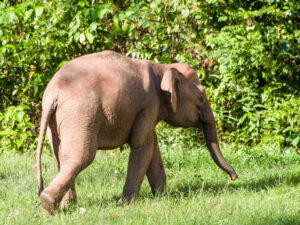
After an early breakfast, depart for the active Lipad Mud Volcano. The soccer field-sized Lipad Mud Volcano serves as a mineral salt lick for wildlife. After trekking through the rainforest for 20 minutes, arrive at the elevated bare area of the mud volcano, which is frequented by wildlife and birds. A nearby fig-tree is a busy feasting place for hornbills and other birds and primates during the fruiting season. Try to identify the multitude of animal footprints here. The adventurous can try the effects of the volcanic mud, said to be responsible for a fine complexion. In the afternoon, try out the Tabin Rainforest Foot Soak made with a natural blend of herbs, to relax tired muscles after long jungle treks. In the evening, join the dusk drive to look out for more nocturnal birds coming out to look for food during this time of the day. After dinner, go for a night walk to discover nocturnal bird species on the nearby trails.
Day 8: Tabin to Danum Valley
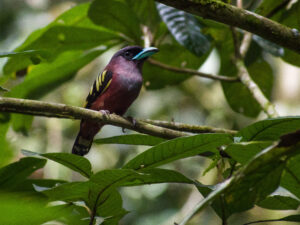
After an early breakfast, you will depart for birding along the road leading to the core area. Stop over and climb up the bird watching tower. The fully regenerated secondary forest with its relatively lower canopy and good natural light provides a delightful birding experience.
Depart Tabin at 10am and travel 3 hours to DVFC, stopping en route for lunch and change of vehicle.
Days 9-10: Danum Valley

Comprising 438,000 hectares of protected lowland forest, research has shown no evidence of permanent human settlement and, since becoming a research centre, very low levels of hunting and poaching.
Danum is home to an astonishing variety of plants and wildlife; including over 340 species of bird, 124 species of mammals, 72 species of reptile and 56 species of amphibians. The flora is as rich as the fauna, with over 200 species of plants found per hectare. In 2019, researchers discovered the tallest tropical tree in the world, a giant reaching 100 metres.
Your itinerary is very flexible. Danum offers a variety of trails, so your days will comprise a lot of exploring.
Again, your guide will give you different options each day depending on tiredness and the particular animals you’re searching for. Night drives are optional on a first come, first served basis. These are to be paid in cash on the day.
Days 11-12: Kinabalu National Park

Kinabalu Park is Malaysia’s first World Heritage Site declared by UNESCO in December 2000 for its ‘outstanding universal values’ and its role as one of the most important biological sites in the world. Kinabalu National Park was gazetted in 1964 to protect Mount Kinabalu and its plant and animal life. Mount Kinabalu, standing at 4,095.2 metres tall, is the highest mountain on the island of Borneo and the 20th most prominent peak in the world. On the west coast of Sabah, Malaysian Borneo, Kinabalu National Park covers an area of 754 square kilometres (291 square miles) and incorporates two mountains, Mount Kinabalu (4095.2 m) and Mount Tambuyukon (2,579 m).
Kinabalu Park, with four climatic zones, boasts one of the richest collections of biodiversity in the world, housing and protecting over 4,500 species of flora and fauna–including 326 bird species, an estimated of over 100 mammal species, over 110 land snail species, and its biggest attraction, Mount Kinabalu. It is also one of the most popular tourist attractions in Sabah and Malaysia. A 2-hour scenic drive from Kota Kinabalu, the capital of Sabah, visitors exploring Kinabalu Park will notice the cooling temperature, ranging from 15 to 24 °C (60 – 78 °F) in the Park. First-time visitors to the Park are often pleasantly surprised to be welcomed by planted beds of brightly coloured flowers.
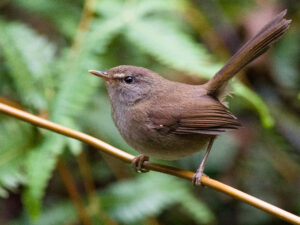
Your specialist guide will meet and greet you upon arrival at Kota Kinabalu airport. From here, you will travel a little over 2 hours to Kinabalu park. Your guide will discuss and answer questions regarding your itinerary en route to the park.
The next couple of days will involve exploring the park. There are many trails here, but we can see most birds on the road from the headquarters to the start of the summit trail. It is a gated road, so the road is quite safe. Only vehicles using the road are staff or minivans ferrying people to the start of the trail. In your free time, explore the area as this is also a fantastic place to see many species of birds.
Day 13: Kinabalu to Kota Kinabalu
We will transfer you to Kota Kinabalu airport. Take an afternoon flight back to Kuala Lumpur.

Checklist
For all our bookings we provide the most accurate and useful printable checklists available, specific to the actual areas you are likely to visit. In the meantime, use our interactive state checklists, or view the species bar chart for this area on eBird:

Important information

As with all Bubo Birding tours, your booking is handled by Asian Adventures.
All our tours are guided by experienced local birding guides, with the support of Mike Prince in the planning, plus post-trip if you are struggling to identify some species from your photos! Mike also leads a few of these trips himself, and this will be made clear to you in the initial planning.
- Prices quoted are per person, assuming a group of 4 or more people.
- International flights are excluded.
- All travellers will require valid visas. Please apply via https://indianvisaonline.gov.in/. Most travellers will be able to apply for an eVisa, and we recommend doing this 6-8 weeks in advance of your trip, although they are usually issued in a few days.
- We may change the itinerary described due to various reasons such as latest birding information, availability of accommodation, state of the roads, and other unexpected factors that, this being India, do pop up from time to time!
- The price includes most meals, except typically where there are options at different prices and it makes sense for guests to decide for themselves at the time. See Asian Adventures for details.
- The final price and itinerary will be confirmed before booking and depending on your expected arrival and departure plans.
See Asian Adventures for full tour details, including accommodation, meal plans, what's included, other exclusions, prices for different group sizes, single room supplements, cancellation policy, and booking process.
